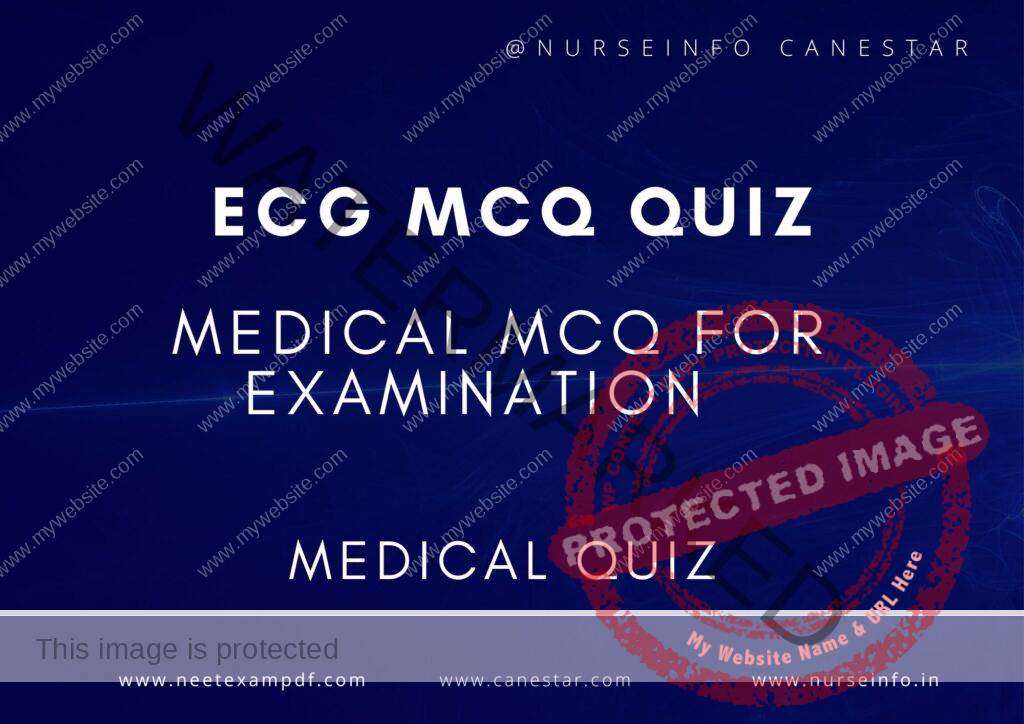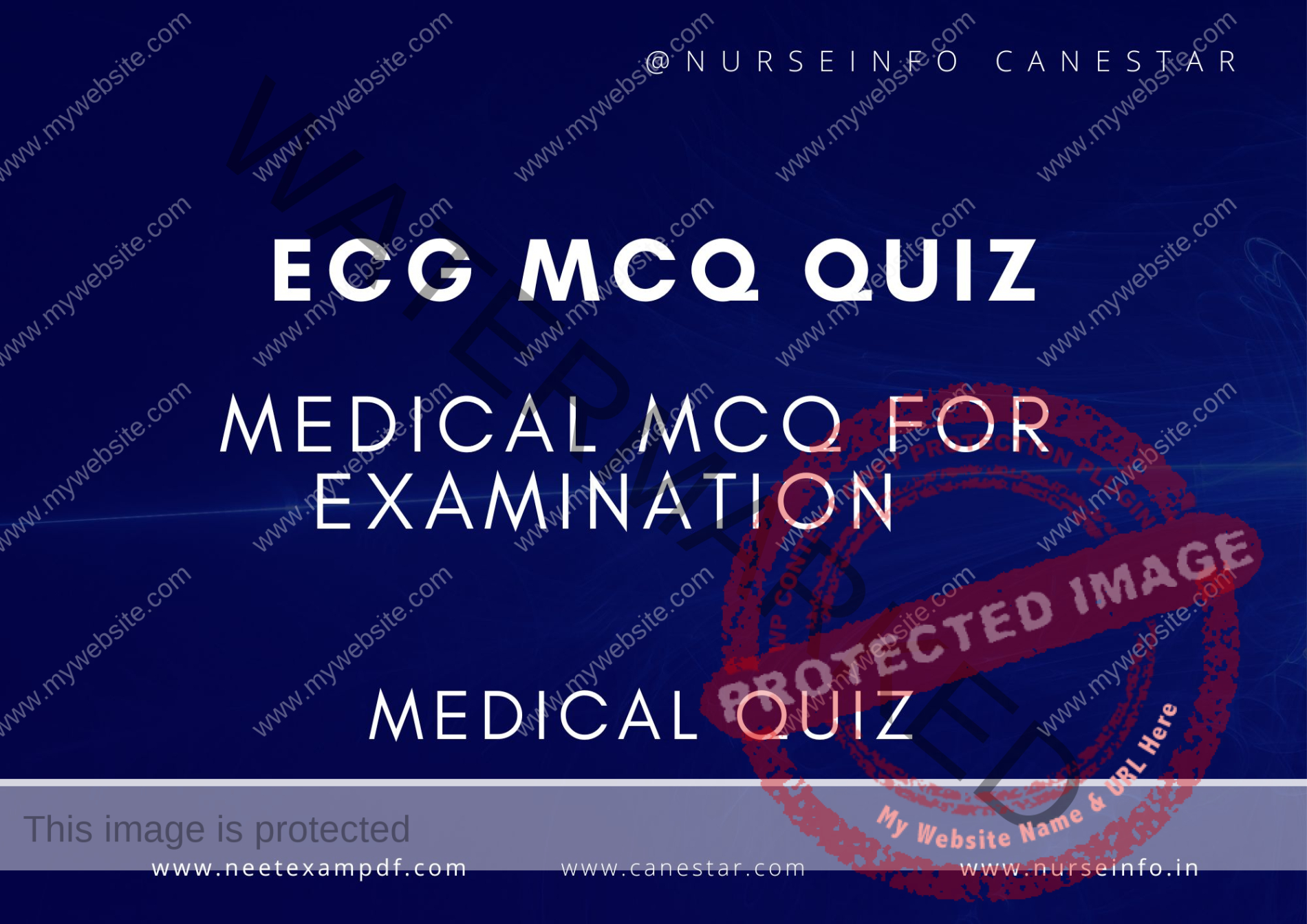MULTIPLE CHOICE QUESTIONS ON ECG EKG INTERPRETATION PRACTICE QUIZ – MCQS WITH RATIONALE ANSWER – ECG EKG INTERPRETATION MCQ QUESTIONS WITH RATIONALE
MCQ FOR ECG EKG INTERPRETATION QUIZ
These mcqs are prepared exclusively for medical professionals for exam preparation. MCQ is helpful to remember the concept on ecg ekg interpretation mcq quiz. This multiple choice questions are helpful for preparation for DHA, PROMETRIC, MOH, HAAD, NCLEX, Medical, NEET and Nursing EXAMINATION
ECG (EKG) INTERPRETATION MCQ QUIZ
Question 1
What is the normal duration of the PR interval on an ECG? A. 0.08-0.12 seconds
B. 0.12-0.20 seconds
C. 0.20-0.24 seconds
D. 0.24-0.30 seconds
Answer: B. 0.12-0.20 seconds
Rationale: The normal PR interval duration ranges from 0.12 to 0.20 seconds. This interval represents the time taken for electrical impulses to travel from the atria to the ventricles.
Question 2
Which ECG finding is indicative of a myocardial infarction (MI)? A. Inverted T waves
B. Tall, peaked T waves
C. ST segment elevation
D. Prolonged QT interval
Answer: C. ST segment elevation
Rationale: ST segment elevation is a classic sign of myocardial infarction (MI), indicating acute injury to the myocardial tissue.
Question 3
What does the presence of Q waves on an ECG suggest? A. Previous myocardial infarction
B. Ventricular hypertrophy
C. Hyperkalemia
D. Early repolarization
Answer: A. Previous myocardial infarction
Rationale: Pathological Q waves typically indicate a previous myocardial infarction and signify areas of necrotic tissue that do not conduct electrical impulses.
Question 4
Which of the following is a hallmark of atrial fibrillation on an ECG? A. Regular RR intervals
B. Absence of P waves
C. ST segment depression
D. Wide QRS complexes
Answer: B. Absence of P waves
Rationale: Atrial fibrillation is characterized by the absence of distinct P waves and an irregularly irregular RR interval due to chaotic atrial activity.
Question 5
A QT interval greater than 0.44 seconds can lead to which of the following conditions? A. Atrial flutter
B. Ventricular fibrillation
C. First-degree heart block
D. Sinus bradycardia
Answer: B. Ventricular fibrillation
Rationale: A prolonged QT interval (greater than 0.44 seconds) can predispose individuals to ventricular arrhythmias, including ventricular fibrillation.
Question 6
What is the significance of tall, peaked T waves on an ECG? A. Hypokalemia
B. Hyperkalemia
C. Hypocalcemia
D. Hypercalcemia
Answer: B. Hyperkalemia
Rationale: Tall, peaked T waves are a classic ECG finding associated with hyperkalemia, indicating elevated potassium levels in the blood.
Question 7
Which ECG change is commonly seen in pericarditis? A. PR segment depression
B. ST segment elevation in all leads
C. Q waves
D. Inverted T waves
Answer: B. ST segment elevation in all leads
Rationale: Diffuse ST segment elevation in most or all leads is commonly seen in acute pericarditis, along with PR segment depression.
Question 8
What does a wide QRS complex indicate? A. Right atrial enlargement
B. Left ventricular hypertrophy
C. Bundle branch block
D. Atrial septal defect
Answer: C. Bundle branch block
Rationale: A wide QRS complex (greater than 0.12 seconds) often indicates a bundle branch block, where there is a delay or obstruction in the electrical conduction through the ventricles.
Question 9
Which rhythm is characterized by a sawtooth pattern on the ECG? A. Atrial fibrillation
B. Atrial flutter
C. Ventricular tachycardia
D. Sinus arrhythmia
Answer: B. Atrial flutter
Rationale: Atrial flutter is characterized by a sawtooth pattern of flutter waves on the ECG, due to rapid atrial depolarizations.
Question 10
In which condition would you expect to see U waves on the ECG? A. Hyperkalemia
B. Hypokalemia
C. Hypercalcemia
D. Hypocalcemia
Answer: B. Hypokalemia
Rationale: U waves are often seen in the context of hypokalemia and represent delayed repolarization of the ventricles.
Question 11
Which of the following is a defining feature of Wolff-Parkinson-White (WPW) syndrome on an ECG? A. Short PR interval
B. Long PR interval
C. ST segment depression
D. T wave inversion
Answer: A. Short PR interval
Rationale: Wolff-Parkinson-White syndrome is characterized by a short PR interval and a delta wave due to the presence of an accessory conduction pathway.
Question 12
What does the presence of a delta wave indicate on an ECG? A. Myocardial ischemia
B. Bundle branch block
C. Pre-excitation syndrome
D. First-degree AV block
Answer: C. Pre-excitation syndrome
Rationale: A delta wave, seen as a slurred upstroke of the QRS complex, is indicative of pre-excitation syndromes such as Wolff-Parkinson-White syndrome.
Question 13
Which ECG finding is associated with hypothermia? A. Osborn waves
B. Tall, peaked T waves
C. ST segment depression
D. QT interval shortening
Answer: A. Osborn waves
Rationale: Osborn waves (also called J waves) are characteristic ECG findings in hypothermia and appear as extra deflections at the end of the QRS complex.
Question 14
What does the presence of ST segment depression suggest? A. Myocardial infarction
B. Myocardial ischemia
C. Hyperkalemia
D. Ventricular hypertrophy
Answer: B. Myocardial ischemia
Rationale: ST segment depression is typically a sign of myocardial ischemia, indicating reduced blood flow to the heart muscle.
Question 15
Which rhythm is indicated by three or more consecutive PVCs on an ECG? A. Atrial flutter
B. Ventricular tachycardia
C. Sinus arrhythmia
D. Junctional rhythm
Answer: B. Ventricular tachycardia
Rationale: Ventricular tachycardia is defined by three or more consecutive premature ventricular contractions (PVCs) and is a potentially life-threatening condition.
Question 16
What does a prolonged PR interval indicate? A. First-degree AV block
B. Second-degree AV block
C. Third-degree AV block
D. Right bundle branch block
Answer: A. First-degree AV block
Rationale: A prolonged PR interval (greater than 0.20 seconds) is indicative of a first-degree AV block, where there is a delay in the conduction from the atria to the ventricles.
Question 17
Which ECG finding suggests hypercalcemia? A. Shortened QT interval
B. Prolonged QT interval
C. Tall, peaked T waves
D. ST segment elevation
Answer: A. Shortened QT interval
Rationale: Hypercalcemia is typically associated with a shortened QT interval due to faster repolarization of the ventricles.
Question 18
Which rhythm is indicated by irregularly irregular RR intervals with no distinct P waves? A. Sinus bradycardia
B. Atrial fibrillation
C. Ventricular fibrillation
D. Sinus tachycardia
Answer: B. Atrial fibrillation
Rationale: Atrial fibrillation is characterized by irregularly irregular RR intervals and the absence of distinct P waves on the ECG.
Question 19
What does a downward sloping ST segment depression indicate? A. Digitalis effect
B. Hyperkalemia
C. Myocardial infarction
D. Atrial flutter
Answer: A. Digitalis effect
Rationale: A downward sloping (scooped) ST segment depression is characteristic of the digitalis effect, seen in patients taking digoxin.
Question 20
Which of the following is a feature of right bundle branch block (RBBB) on an ECG? A. M-shaped QRS complexes in V1 and V2
B. Q waves in leads I and AVL
C. Left axis deviation
D. Prolonged QT interval
Answer: A. M-shaped QRS complexes in V1 and V2
Rationale: Right bundle branch block is characterized by M-shaped (bunny ears) QRS complexes in the right precordial leads (V1 and V2), indicating delayed conduction through the right ventricle.


